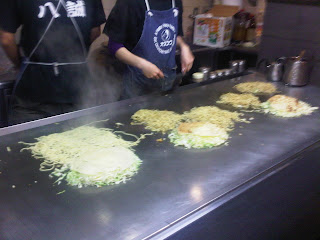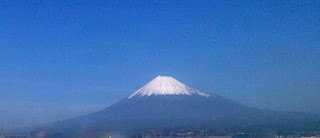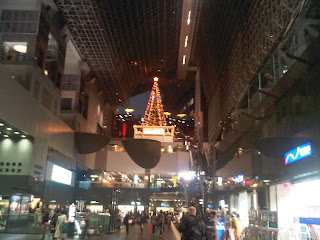It could have been worse. I could have gained many pounds from all the delicious food I ate in Japan. Luckily I only gained two pounds. It amazes me how slender most Japanese people are despite the size of the portions we were served in many of the meals we ate. The Japanese diet is considered to be very healthy and from what I could see the Japanese walk more than most Americans do (particularly me these days). There were some hints, however, that diet might change in Japan to be more like the garbage Americans eat. We saw a number of people buying doughnuts from places like Krispy Kreme. And
McDonald's is making huge inroads with its oversized hamburgers.
At the same time, there are more vegetarian options in Japan than ever before. I have been trying to be a vegetarian (sometimes I lapse) so my Japanese friends found vegetarian restaurants for us, which may not be completely representative of Japanese food but certainly were different from American vegetarian restaurants.
Our first Japanese restaurant meal in Tokyo was dinner at a Shabu Shabu restaurant on the 38th floor of the Yebisu Garden Tower near our hotel. Unfortunately I did not get any pictures of the food there, focussing more on the fantastic views of Tokyo. Here is a photo that looked much like what we ate. So much for no meat!
 |
| Shabu Shabu © 2009 Bermi Ferrer Creative Commons license |
The next day, after our trip to Meiji Shrine, we had lunch at the vegetarian restaurant
Hanada Rosso (see also
here). I had a delicious vegetarian burger in tomato sauce with side dishes. The chef,
Minako Hanada, is reportedly a celebrity chef in Japan.
 |
| Lunch at Hanado Rosso in Harajuku |
We also had vegetarian meals at an Indian restaurant, Nataraj, in Ginza area of Tokyo and at Miko-an in downtown Kyoto. Unfortunately I do not have pictures of what we ate at either place but both were superb. Someone else's
blog entry about Miko-an has some great pictures of the food and the restaurant. Some
photos of Nataraj can be seen here.
My husband is not terribly fond of vegetarian food but he loves tofu. The very first thing we did after arriving in Kyoto at about 2:30 pm on Monday, December 6, was to head out to find a particular tofu restaurant recommended by his friend from Kyoto and by one of our guidebooks. Okutan is across from Nanzen-ji and must get enough tourists to prompt the sign saying "We only have Tofu course". We did not care and were thrilled with the different ways they served tofu.
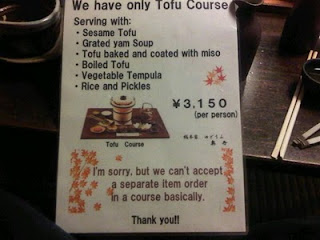 |
| Okutan menu in english |
 |
| Sesame Tofu, Yam soup, sake, tofu pot |
 |
| Baked Tofu with Miso glaze |
 |
| Okutan (Kyoto) interior |
We tried a few specialities in places. Nara Udon was delicious and a real find after we missed out on the restaurant where we had wanted to go because it had closed. In Kyoto, we ate a donburi dish, a chicken and semi cooked egg over rice bowl, called oyakadon which is the speciality of the restaurant "
Hisago". We also ate sushi twice in the Kyoto train station, once in a restaurant and the other time in a sushi bar with a conveyor belt (kaiten-zushi) called
Musashi. And in Hiroshima we tried the okonomiyaki, a pancake based dish (although locals call it Japanese pizza) with vegetables, egg, fish (in my case) and a sauce which I am told can be made from ketchup, worcestershire sauce, soy sauce and mayonnaise. It tastes better than it sounds!
 |
| Nara Udon |
 |
| Chicken and egg bowl, oyakadon, which is the speciality of the restaurant "Hisago" ©Reiko Yabu 2010 |
 |
| Sushi and tempura in Kyoto train station |
 |
| Okonomiyaki in Hiroshima- Seafood special |
Then there were the cakes-- probably my real downfall in terms of causes of weight gain--although the portions were not large like they are in the US. First, we discovered a Christmas roll cake at Starbucks that was a small green tea cake with jelly and whipped cream topping. Why doesn't Starbucks here have something so delicious?! The picture makes it look large but it was fairly small. We ate that a lot- splitting it with a cuppa in the evening. Then we also tried the famous Kyoto roll and some other Kyoto cake in the train station with Kyoto siphon coffee (a great place to eat). On the Philosopher's Path in Kyoto we shared lovely pieces of homemade apple and blueberry cake ("my wife make them") in a restaurant called Pomme.
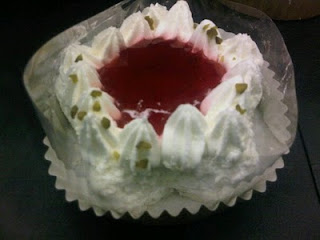 |
| Christmas cake at Starbucks. YUM! |
 |
| Kyoto Roll at Kyoto station |
 |
| Homemade cakes at Pomme on Philosophers Path in Kyoto |
 |
| Pomme in Kyoto |
 |
| Another Kyoto cake at the train station |
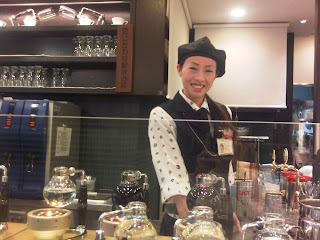 |
| Kyoto siphon coffee in train station |
Gaining a few pounds was well worth it to eat all these scrumptious foods in Japan!

